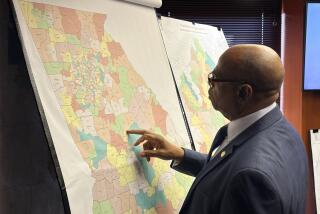Op-Ed: Will the Supreme Court strike down extreme partisan gerrymandering?
The U.S. Supreme Court this fall will hear a series of blockbuster cases dealing with core constitutional rights and basic national values. Among the most important is Gill vs. Whitford, a Wisconsin case that asks the justices to address the toxic threat of partisan gerrymandering. With Whitford, Americans — who by wide margins say they are fed up with gerrymandering — may finally get the breakthrough they have long sought.
The court has already tried and failed several times to limit politicians’ power to manipulate electoral maps for partisan ends. Its failures have paved the way for so-called extreme partisan gerrymanders, electoral maps drawn by politicians and paid consultants that lock in a statewide majority for their party, through good and bad election cycles.
But there is reason to believe that the Wisconsin case, which the court will take up Oct. 3, may turn out differently. Several crucial factors have aligned to make judicial action both relatively easy and absolutely necessary.
To start, the Wisconsin voters who brought the case aren’t asking the court to rule on everything that’s problematic about the ways our districts are created and our legislatures operate. They simply want the court to determine if Wisconsin’s General Assembly map — a textbook example of extreme gerrymandering — is beyond the constitutional pale. (Of course, a ruling against Wisconsin would have ramifications for extreme gerrymanders elsewhere in the country.)
Maps are only going to get more extreme if gerrymandering isn’t curbed now.
In 2010, Wisconsin Republicans rode a wave election to a majority in the state Legislature. They then used their majority — and the control over the redistricting process it got them — to draw new electoral maps. A team of aides and consultants supervised by the leaders of the state’s Republican caucus retreated to an off-site “map room,” where they used voter data and statistical analyses to engineer a map that would, according to one aide’s notes, “determine who’s here 10 years from now.” Their plan worked: In 2012, Republicans won 60 out of the assembly’s 99 seats with just 48.6% of the two-party statewide vote, and Republicans have maintained their majority since.
When the court considers Wisconsin’s extreme map, two facts should help soothe twin concerns that it expressed when it last addressed the constitutionality of partisan gerrymandering in the mid-2000s: that unconstitutional gerrymanders are too hard to separate from run-of-the-mill, legal ones and that a ruling by the court banning certain kinds of gerrymanders might lead to a flood of redistricting litigation.
For now, Wisconsin-type extreme gerrymandering is likely limited to a handful of congressional maps and less than a dozen state legislative maps. And its harm — the decade-long entrenchment of a single party — is a particularly stark one, both because it is so flagrant and because it so clearly violates core American commitments to representative and accountable legislatures.
New developments in social science should also help the court feel more comfortable with policing extreme gerrymanders. Since the mid-2000s, many novel methods have emerged to reliably flag maps that are biased in favor of one party. These methods include both measures of “partisan symmetry” (which show when a map favors one party over another in translating votes into seats) and simulated mapping applications (which show when maps are biased at a level that could only be intentional). Many of the worst maps, including Wisconsin’s, violate multiple such methods, making them easy cases.
What’s more, there’s been a political realignment around the issue that should undercut any sense that the Wisconsin suit is a party power-play in disguise. Current and former elected officials from both parties — including Sen. John McCain (R-Ariz.), Sen. Sheldon Whitehouse (D-R.I.), former Republican Gov. Arnold Schwarzenegger of California, Republican Ohio Gov. John Kasich, and Rep. Nancy Pelosi (D-Calif.) — have joined together to demand a judicial response to the problem. This bipartisan chorus demonstrates that the Wisconsin case isn’t about which party wins. Instead, it’s about whether voters will get representative and accountable legislatures.
These calls are being echoed by legions of political scientists, law professors, historians, legal advocates, civil rights organizations and civil society groups. Their expertise and experience tell them the same thing that elected officials have learned from their time in office: Partisan gerrymandering has reached an intolerable limit, by any measure and any framework.
Maps are only going to get more extreme if gerrymandering isn’t curbed now. During the 2010 cycle, crafty mapmakers used extensive voter data and powerful mapping programs to expertly pack voters and entrench their parties. Since then, computers have only gotten faster, voter data richer, and mapping programs more sophisticated. These developments threaten to make precise, pernicious gerrymandering easier than ever.
With the next round of redistricting coming in 2021, relief from the Supreme Court couldn’t come soon enough.
Thomas P. Wolf is counsel, and Michael C. Li senior counsel, at the Brennan Center for Justice at NYU School of Law.
Follow the Opinion section on Twitter @latimesopinion or Facebook
More to Read
A cure for the common opinion
Get thought-provoking perspectives with our weekly newsletter.
You may occasionally receive promotional content from the Los Angeles Times.






